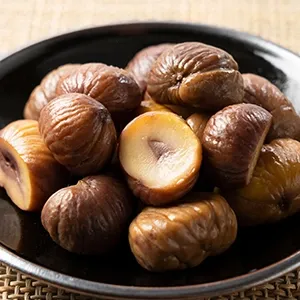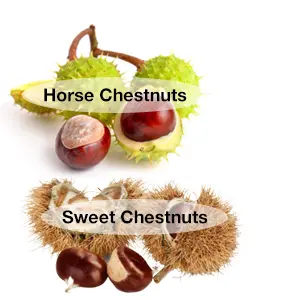Could Chestnuts Be Your Pet's New Favorite Treat
Popular during the holidays, this sweet and savory nut offers an array of health-boosting nutrients and bioactive compounds, and the good news is you can also share it as a healthy treat with your pet this season of giving!

STORY AT-A-GLANCE
- The most notable benefit of chestnuts lies in their rich antioxidant profile. Studies show the antioxidant content of chestnuts is higher than that of many other food crops
- Chestnuts are a good source of antioxidants, including ascorbic acid (vitamin C), carotenoids and phenolic compounds such as gallic and ellagic acids
- Chestnuts contain betaine, a compound that acts as an osmolyte, facilitating water uptake and retention to protect the cell structure from damage, particularly in the kidneys and the gut
- Chop, crush or mash chestnuts before serving them to your pet to avoid any choking risk
- You can use them as an ingredient in your pet's nutritionally balanced, homemade meal or training treat, or as a food topper
Editor's Note: This article was originally published December 21, 2023.
You may have heard of chestnuts from the popular carol, "A Christmas Song." They're almost synonymous with the holidays, and although they're not as common as shortbread cookies and eggnog nowadays, they're certainly healthier, and remain a traditional Christmastime symbol that represents abundance and the spirit of giving.1,2 You know who else you can share chestnuts with? Your pet!
Continue reading to learn all about the health benefits chestnuts have to offer and how you can make them a part of your furry friend's diet.
Chestnuts Fun Fact

Savory and sweet, chestnuts are a winter crop prevalent in stores from Thanksgiving to the New Year's holiday.3 December 14 is celebrated as the National Roast Chestnuts day, honoring the time-honored tradition of roasting chestnuts during the season of good cheer.4
What Are Chestnuts and Are They Safe for Pets?
Chestnuts (Castanea sp.) have been a staple food since ancient times. In the U.S., the American chestnut (Castanea dentata) used to be a majestic tree dominating eastern U.S. forests, providing ample amounts of nuts that served as food to both people and wildlife, as well as providing a hardy lumber suitable for furniture and building material.5
Unfortunately, a deadly blight caused by the pathogen Cryphonectria parasitica, believed to have been brought by Asian chestnut trees introduced to the U.S., caused the downfall of American chestnuts, rendering them virtually extinct. Today, the European chestnut (Castanea sativa), also known as the sweet chestnut, has become the most common type of chestnut for consumption.6 Hence, we will focus on this variety in this article. According to a peer-reviewed paper published in the journal Foods:7
"Chestnuts also have a significant antioxidant activity associated with polyphenolic and organic contents. The composition of chestnuts, in different processing, estimated by the United States Department of Agriculture, confirmed that chestnuts are rich in starch, minerals, vitamins, and phytonutrients, and low in calories and fat."
The vitamins found in chestnuts include ascorbic acid and vitamins B1, B2, B3, B6 and E, which may help promote healthy skin and improve brain function. Minerals are equally crucial for proper physiological functions, and the ones found in chestnuts include calcium, magnesium and potassium.8
However, the most notable benefit of chestnuts lies in their rich antioxidant profile. A study published in the journal Food Chemistry reports that the antioxidant content of chestnuts is higher than that of many other food crops.9
Chestnuts Provide Assorted Antioxidative Compounds
"Chestnuts are a good source of various antioxidants, including ascorbic acid (vitamin C), carotenoids and phenolic compounds such as gallic and ellagic acids."10
Gallic acid, in particular, is a polyphenol that has antioxidant, anti-inflammatory and antimicrobial properties. A study published in the journal Frontiers in Immunology evaluated the effect of this compound on puppies under environmental stress and found that it helped inhibit stress-related gut microbiome imbalance by alleviating oxidative stress and inhibiting inflammatory responses.11
Ellagic acid also had similar benefits to the gut microbiota, according to an animal study published in the journal Animals. According to the researchers, ellagic acid "plays an important role against oxidative damage, inflammation, and Gram-positive pathogen infection." It's also been found to improve intestinal barrier function.12
Chestnuts also contain significant levels of the carotenoid lutein, which is crucial for your pet's eye health.13 As for their vitamin C content, a single chestnut provides 2.08 milligrams of this vitamin,14 which helps improve your pet's health by scavenging free radicals and supporting cognition and skin health.15,16 While pets can synthesize their own vitamin C, getting this nutrient from fresh food sources may benefit their well-being.
Betaine in Chestnuts Helps Support Your Pet's Kidneys
Betaine is a compound that acts as an osmolyte, facilitating water uptake and retention to protect the cell structure from damage. It has specific receptors that allow it to be efficiently utilized in the gut and the kidneys. Studies showed that betaine may help reduce homocysteine, which is considered a uremic toxin, especially for pets with chronic kidney disease (CKD).17,18
Low circulating levels of betaine have also been associated with CKD progression. By helping support the kidney cells and improving intestinal integrity, researchers suggest this compound may be useful in CKD treatment.19,20,21
Keep Your Pet Away From Horse Chestnuts

Be careful not to confuse sweet chestnuts with horse chestnuts. Also known as buckeyes, horse chestnuts (Aesculus hippocastanum) look similar to sweet chestnuts, but they belong to a different plant family (Hippocastanaceae) and are toxic to animals.22 When consumed, horse chestnuts can cause severe vomiting, diarrhea, loss of balance, convulsions and even coma.23
Always buy chestnuts from the supermarket to make sure you're getting the edible kind. Avoid foraging, especially if you're not an expert at telling horse chestnuts and sweet chestnuts apart. If you have a horse chestnut tree near your home, keep your pet away from it.
Chestnuts Are Starchy, so Feed Sparingly
Starch is one of chestnuts' major constituents. In fact, chestnuts are considered one of the richest sources of starch, often compared to potatoes. They contain 22.3 grams of this macronutrient per 100-gram serving.24 The uncooked kernels have a glycemic index of 54.25
Since your pet has no biological need for starch in their diet, feed cooked chestnuts sparingly, as a special holiday training treat or meal topper. You can also use chestnuts as an ingredient in your pet's nutritionally balanced, homemade meal. Keep in mind that healthy treats should make up less than 10% of your pet's daily caloric intake.
More Tips on Choosing Chestnuts and Serving Them to Pets
When buying chestnuts, choose nuts that have tight, shiny skin without any mold on their surface. They should also be heavy for their size and not rattle in their shell; rattling inside indicates that they're old. Fresh chestnuts are perishable because of their high water content, so make sure to store them in an airtight container and place in the fridge, where they can last for a few months. You can also buy canned chestnuts year-round, but be careful to avoid sweetened varieties.26
One important caveat about raw chestnuts is that they contain high amounts of tannins,27 an antinutrient that can cause stomach upset and nausea when consumed in excessive amounts. This is why you should make sure to cook chestnuts before eating them or offering them to pets. Soaking scored chestnuts in water overnight prior to cooking also helps reduce their tannin content28 and makes them easier to peel.29
Chestnuts are commonly enjoyed roasted; put them on a baking sheet and roast in an oven at 245 degrees F (118 degrees C) for 45 to 50 minutes, stirring occasionally. You can also boil chestnuts until they're tender, about 15 to 25 minutes. It's best to peel chestnuts while they're still hot, because the shell is difficult to separate from the flesh once they've cooled.30
Chop, crush or mash chestnuts before serving them to your pet to avoid any choking risk. You can offer bite-sized pieces of chestnuts as rewards or mashed chestnuts can be spread on your pet's lick mat or stuffed in an interactive toy.
Which States Produce the Most Chestnuts?

The U.S. is one of the few countries that can grow chestnuts. The top five chestnut-producing states are Michigan, Florida, California, Oregon and Virginia, with a total of approximately 3,700 acres of chestnut trees.31

Is Chestnut Production Sustainable?
Chestnut production does not cause significant damage to environmental resources. Producing a kilogram of chestnuts consumes 2,750 liters of water, which is considered a moderate water footprint. In terms of carbon footprint, a kilogram of chestnuts takes 2 kilograms of CO2e to produce, which is equivalent to a car driving 5 miles (8 kilometers). Overall, chestnut production is considered "moderately sustainable," according to HEALabel.32
Sources and References
- 1 Heart of England Forest, Sweet Chestnut
- 2,3 The Spruce Eats, December 20, 2020
- 4 Tasting Table, The Symbolic Reason Chestnuts Are Eaten On Christmas
- 5 The American Chestnut Foundation, History of the American Chestnut Tree
- 6,26 The Spruce Eats, September 12, 2022
- 7,8,10,27 Foods 2022, 11(24), 4052
- 9 Food Chemistry. Volume 395, 30 November 2022, 133575
- 11 Front Immunol. 2022 Jan 14:12:813890
- 12 Animals 2022, 12(9), 1180
- 13 International Journal of Food Science and Technology, Volume 45, Issue 3
- 14 USDA Food Data Central, Chestnuts
- 15 American Kennel Club, March 14, 2024
- 16 Whole Dog Journal, April 24, 2001
- 17,20 BMC Veterinary Research volume 16, Article number: 75 (2020)
- 18,21 International Urology and Nephrology Volume 53, Pages 539–551 (2021)
- 19 Open Access Government July 2023, pp.512-513
- 22 Michigan State University Extension, Chestnuts
- 23 ASPCA, Horse Chestnut
- 24 J Food Sci Technol. 2016 Jan; 53(1): 348–358
- 25 Acta Horticulturae June 2010 866(866):659-666
- 28 Food Chemistry. Volume 63, Issue 2, October 1998, Pages 259-264
- 29 Foolproof Living, December 22, 2021
- 30 The Spruce Eats, January 9, 2020
- 31 Agricultural Marketing Resource Center, Chestnuts
- 32 HEALabel, January 2, 2023











